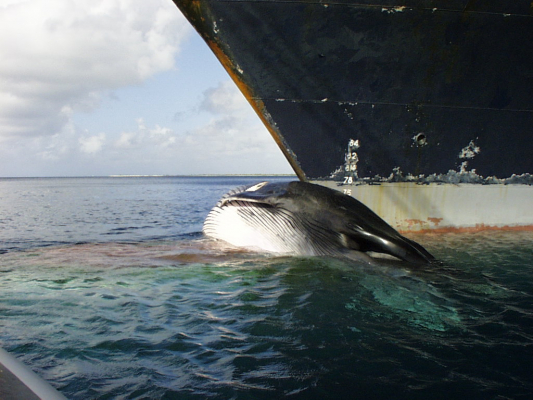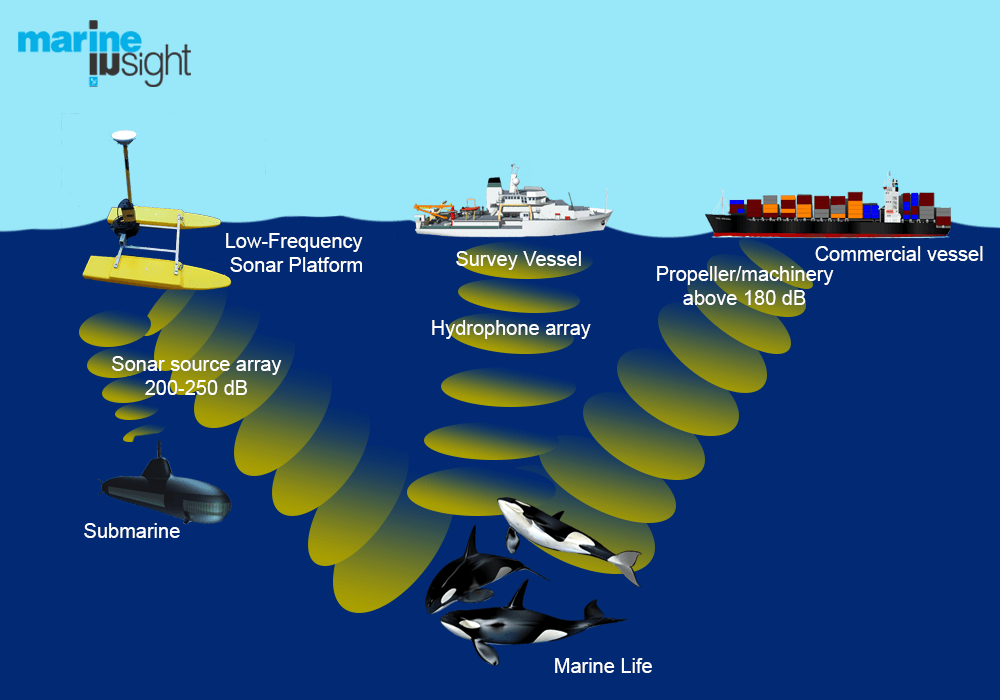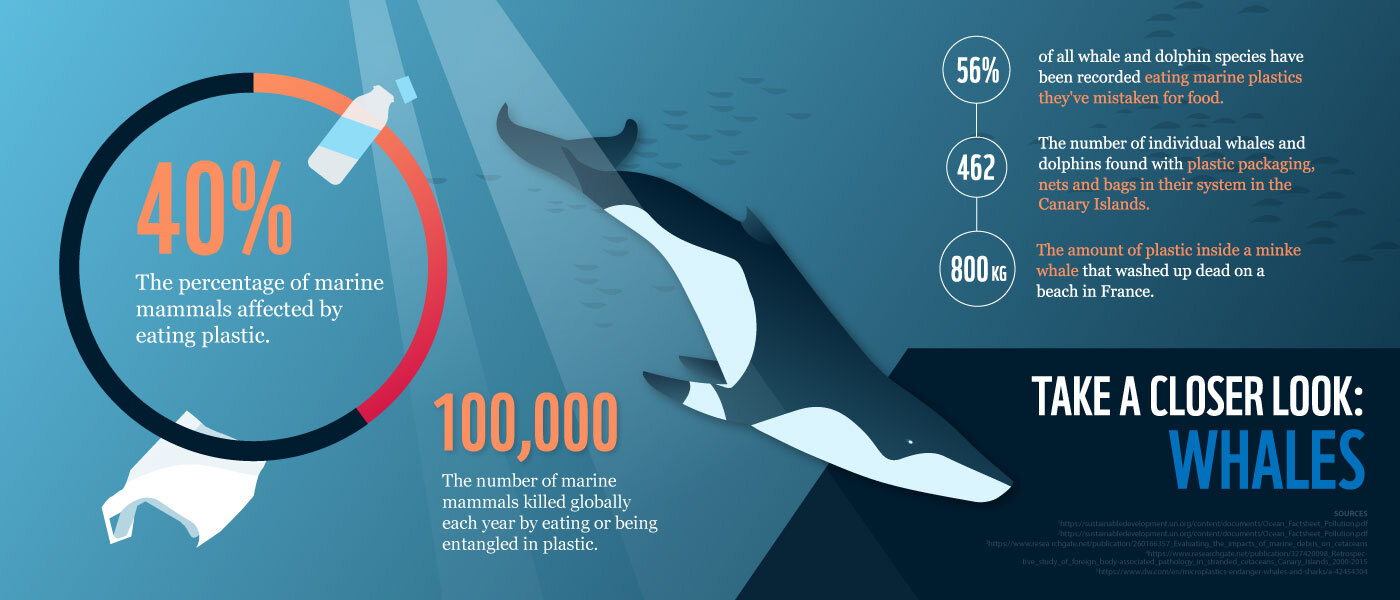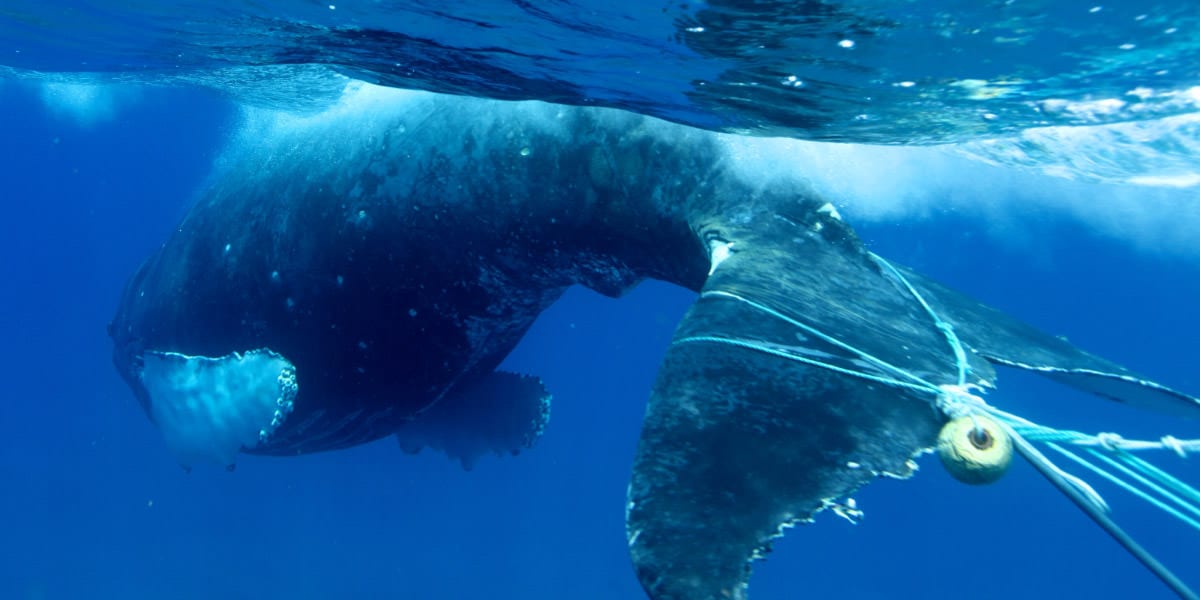Current Threats
Commercial whaling officially ended in the United States in 1972. Yet, due to a variety of our activities we are still responsible for killing hundreds of animals annually. The irony is the actual whale hunts typically killed the animals in seconds or minutes. Death by entanglement may take months of agony, infection and slow starvation.
Entanglements

Caption: North Atlantic right whale, catalog number unknown. Photo credit: EcoHealth Alliance, NOAA Permit # 932-1905.
Entanglement in fixed fishing gear may be the greatest threat to survival for this family of marine mammals. Trap/pot fisheries are an important part of coastal economies. But, the vertical lines needed to mark the locations of the traps and pots pose a constant danger to the animals. Once they make contact with a rope, they tend to roll into it rather than away, thus getting them more tangled. This often results in an animal pulling numerous traps for long distances over days, weeks or months.
The strength of vertical line has increased over the past 20 years, plus traps are more likely to be wire instead of wood. Thus it is less likely that these animals can break free, and are forced to drag around heavy sets of lines, traps, and anything in the traps. This leads to increased energy use, decreased feeding ability, decreased ability to reproduce, lines digging into the animal’s skin, risk of injury, infection, probably great pain, and occasionally a slow, inhumane death.
Vessel Strikes

Photo Credit: David Laist from IWC website
Collisions between whales and vessels on the water are known as ‘vessel strikes’. Cetaceans of all sizes can be struck and injured, or killed, by vessels of all sizes. Collisions between these animals and smaller boats, along with being dangerous or deadly for the whales, often results in damage to the boats, and injuries or death to those on board. Collisions between cetaceans and larger vessels, such as container ships, lead to the death of these animals, many of whom are carried far from the site of impact before it is noticed that they are attached to the ship. Our blue whale is an example of this. This is a global problem because nearly 90% of the shipping of goods is done on waterways.
Climate Change
The impacts to cetaceans of changing ocean temperatures are still being studied. There is a concern that the timing and productivity of food chains will be altered and that species higher up on the food chain won’t adapt quickly enough. Prey species may move to new habitat, forcing cetaceans to search for food in unfamiliar areas. Warmer water doesn’t hold as much oxygen as colder water. Warmer temperatures may lead to more harmful algal blooms.
Noise

Image Credit: from marineinsight.com
Human activity is adding increasing levels of unnatural noise to the ocean. Shipping, recreational boating, seismic testing for petroleum beneath the surface of the ocean, and pile driving to make shoreside structures, each add sound to the ocean. Combined, these sources of noise create an environment that makes communication difficult for animals, like whales, that are dependent on sound to make sense of their world. This ‘masking’ of natural sounds has forced some cetaceans to make louder sounds, similar to shouting. This uses more energy. Blue whales have the ability to communicate across entire ocean basins when their habitat is quiet. This may not be possible anymore.
NRDC Film – Lethal Sounds: Deadly Sonar Harms Whales
Pollution

Pollution in all its forms is a persistent and growing problem in the ocean. Macroplastics, microplastics, other debris, and abandoned fishing gear have a negative impact on cetaceans that rely on suction feeding to swallow their prey. Runoff from heavily fertilized lawns and farmland, sewage effluent, industrial processes, and airborne pollutants may not be as visible, but they increase toxin levels in the water. These toxins move through the food chain and accumulate in the muscle and blubber of sperm whales, dolphins, belugas and other species. Mothers pass along these poisons through their milk to their calves when nursing. An orca that washed ashore in Scotland in 2017 had PCB (a group of persistent cancer causing compounds) concentration 100 times the level considered harmful. These dead animals often have to be disposed of like hazardous waste.
Plastic bags are especially problematic. Animals mistake bags, or pieces of bags, as food and ingest them. They persist in the environment for centuries. More than 100,000 marine mammals are killed by plastic bags each year.
Prey Availability / Habitat Quality
Human activity can also have an impact of availability of prey and the quality of the habitat where both prey and cetacean live and feed.
- Southern Resident Orca numbers are in steep decline due to lack of their favorite food, salmon. The salmon are declining due to dams on their spawning rivers.
- The Deepwater Horizon oil spill in 2010 coated 68,000 square miles (180,000 square km) of ocean.
- The long-term impact of wind farms is still being studied. Early results show them to be attractive to many marine species.
- Natural cycles such as El Niño and La Niña, change the availability of food, often creating boom and bust cycles of available prey.


